AWS Machine Learning Blog
Save the date for the AWS Machine Learning Summit: June 2, 2021
On June 2, 2021, don’t miss the opportunity to hear from some of the brightest minds in machine learning (ML) at the free virtual AWS Machine Learning Summit. Machine learning is one of the most disruptive technologies we will encounter in our generation. It’s improving customer experience, creating more efficiencies in operations, and spurring new […]
Use computer vision to detect crop disease through image analysis with Amazon Rekognition Custom Labels
Currently, many diseases affect farming and lead to significant economic losses due to reduction of yield and loss of quality produce. In many cases, the health condition of a crop or a plant is often assessed by the condition of its leaves. For farmers, it is crucial to identify these symptoms early. Early identification is […]
Join AWS at NVIDIA GTC 21, April 12–16
Starting Monday, April 12, 2021, the NVIDIA GPU Technology Conference (GTC) is offering online sessions for you to learn AWS best practices to accomplish your machine learning (ML), virtual workstations, high performance computing (HPC), and Internet of Things (IoT) goals faster and more easily. Amazon Elastic Compute Cloud (Amazon EC2) instances powered by NVIDIA GPUs […]
Build a CI/CD pipeline for deploying custom machine learning models using AWS services
Amazon SageMaker is a fully managed service that provides every developer and data scientist with the ability to build, train, and deploy machine learning (ML) models quickly. SageMaker removes the heavy lifting from each step of the ML process to make it easier to develop high-quality ML artifacts. AWS Serverless Application Model (AWS SAM) is […]
How Digitata provides intelligent pricing on mobile data and voice with Amazon Lookout for Metrics
This is a guest post by Nico Kruger (CTO of Digitata) and Chris King (Sr. ML Specialist SA at AWS). In their own words, “Digitata intelligently transforms pricing and subscriber engagement for mobile operators, empowering operators to make better and more informed decisions to meet and exceed business objectives.” As William Gibson said, “The future […]
Rust detection using machine learning on AWS
Visual inspection of industrial environments is a common requirement across heavy industries, such as transportation, construction, and shipbuilding, and typically requires qualified experts to perform the inspection. Inspection locations can often be remote or in adverse environments that put humans at risk, such as bridges, skyscrapers, and offshore oil rigs. Many of these industries deal […]
Aerobotics improves training speed by 24 times per sample with Amazon SageMaker and TensorFlow
Editor’s note: This is a guest post written by Michael Malahe, Head of Data at Aerobotics, a South African startup that builds AI-driven tools for agriculture. Aerobotics is an agri-tech company operating in 18 countries around the world, based out of Cape Town, South Africa. Our mission is to provide intelligent tools to feed the […]
AWS ML Community showcase: March 2021 edition
In our Community Showcase, Amazon Web Services (AWS) highlights projects created by AWS Heroes and AWS Community Builders. Each month AWS ML Heroes and AWS ML Community Builders bring to life projects and use cases for the full range of machine learning skills from beginner to expert through deep dive tutorials, podcasts, videos, and other […]
Configure Amazon Forecast for a multi-tenant SaaS application
Amazon Forecast is a fully managed service that is based on the same technology used for forecasting at Amazon.com. Forecast uses machine learning (ML) to combine time series data with additional variables to build highly accurate forecasts. Forecast requires no ML experience to get started. You only need to provide historical data and any additional […]
Introducing Amazon Lookout for Metrics: An anomaly detection service to proactively monitor the health of your business
Anomalies are unexpected changes in data, which could point to a critical issue. An anomaly could be a technical glitch on your website, or an untapped business opportunity. It could be a new marketing channel with exceedingly high customer conversions. As businesses produce more data than ever before, detecting these unexpected changes and responding in […]









